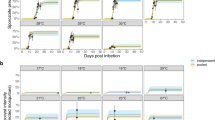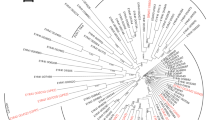Abstract
THE common house mosquito, Culex pipiens, has two different forms with respect to egg formation. Adult females of the so-called autogenous form can lay the first batch of eggs without taking a blood meal, whereas anautogenous females will not produce mature eggs until they have ingested blood. In spite of the many investigations of these two mosquito forms, very little is known about the physiological and biochemical basis of autogeny or anautogeny1–3. Egg formation in adult mosquitoes has been considered to depend on the nutritional reserve stored during larval development4,5; at emergence autogenous females contain more fat reserve than anautogenous females6,7. But, as Clements has pointed out8, the quantity of reserve materials cannot be the deciding factor for initiating ovarian development, because even in the anautogenous form there should be still a sufficient nutritional storage to produce a limited number of eggs. Investigation of the hormonal system revealed that the corpora allata of the autogenous females are active after emergence, whereas the anautogenous females do not secrete the gonadotrophic hormone until after they have fed on blood9–12. There is now no doubt that ovarian development in mosquitoes, as in all insects, is under hormonal control, but it is not known why the endocrine system is maintained in an active state even without feeding only in the autogenous form, while that in the anautogenous form requires a blood meal for activation.
This is a preview of subscription content, access via your institution
Access options
Subscribe to this journal
Receive 51 print issues and online access
$199.00 per year
only $3.90 per issue
Buy this article
- Purchase on Springer Link
- Instant access to full article PDF
Prices may be subject to local taxes which are calculated during checkout
Similar content being viewed by others
References
Laven, H., Z. Vererbungslehre, 88, 443 (1957).
Chen, P. S., J. Insect Physiol., 3, 335 (1959).
Clements, A. N., The Physiology of Mosquitoes (Pergamon Press, London, 1963).
De Boissezon, P., C.R. Soc. Biol., Paris, 114, 487 (1933).
Rouband, E., Ann. Sci. Nat. Zool., 16, 5 (1933).
Möllring, F. K., Z. Tropenmed. Parasitol., 7, 15 (1956).
Twohy, D. W., and Rozeboom, L. R., Amer. J. Hyg., 65, 316 (1957).
Clements, A. N., J. Exp. Biol., 33, 211 (1956).
Detinova, T. S., Zool. Zh., 34, 291 (1945).
Mednikova, M. V., Zool. Zh., 31, 676 (1952).
Gillette, J. D., Nature, 180, 656 (1957).
Larsen, J. R., and Bodenstein, D., J. Exp. Zool., 140, 343 (1959).
Chen, P. S., J. Insect Physiol., 9, 453 (1963).
Geiger, H. R., Rev. Suisse Zool., 68, 583 (1961).
Chen, P. S., J. Insect Physiol., 2, 38 (1958).
Chen, P. S., J. Insect Physiol., 2, 128 (1958).
Davis, B. J., Ann. NY Acad. Sci., 121, 404 (1964).
Author information
Authors and Affiliations
Rights and permissions
About this article
Cite this article
CHEN, P. Electrophoretic Patterns of Larval Haemolymph-proteins in Autogenous and Anautogenous Forms of Culex pipiens L.. Nature 215, 316–317 (1967). https://doi.org/10.1038/215316a0
Received:
Issue Date:
DOI: https://doi.org/10.1038/215316a0
This article is cited by
-
Nutrition and reproduction in haematophagous arthropods
Proceedings: Animal Sciences (1987)
Comments
By submitting a comment you agree to abide by our Terms and Community Guidelines. If you find something abusive or that does not comply with our terms or guidelines please flag it as inappropriate.



